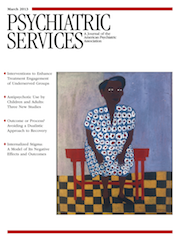A Model of Internalized Stigma and Its Effects on People With Mental Illness
Abstract
Objectives
The investigators aimed to examine the prevalence of internalized stigma among individuals with serious mental illness and to construct and test a hypothesized model of the interrelationships among internalized stigma, self-concept, and psychiatric symptoms.
Methods
One hundred individuals, most of whom were African American and had a diagnosis of serious mental illness, were receiving mental health services from one of three community outpatient mental health programs or one Veterans Affairs medical center. They completed an interview that included measures of internalized stigma, psychiatric symptoms, self-esteem, self-efficacy, and recovery orientation. Structural equation modeling (SEM) was used to examine the interrelationships among these variables.
Results
Thirty-five percent of participants reported moderate to severe levels of internalized stigma, which was not significantly associated with any demographic variable or diagnosis. However, greater internalized stigma was associated with lower levels of self-esteem, self-efficacy, and recovery orientation, as well as with more severe psychiatric symptoms. The SEM produced a nonsignificant chi square statistic and other fit indices indicative of a good model fit (goodness-of-fit index=.96, root mean square error of approximation=.011).
Conclusions
Results suggest that internalized stigma was prevalent and problematic among individuals with serious mental illness. There may be multiple pathways through which stigma and discrimination lead to negative outcomes, suggesting that interventions to reduce internalized stigma need to target multiple points along these pathways in order to be effective.



